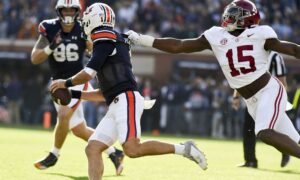Keeping Dynasty Weird: The Delayed Dynasty League

I’ve talked in the past about my first tepid foray into devy leagues, but in case you’ve missed that, I’ll give a short summary. I joined a dynasty league run by our own Steve Wyremski, which allowed each owner to draft one college player per season. That player remained with the team until he entered the NFL. There were some strict rules regulating which players could be drafted and how they would be handled. This was just enough to whet my appetite for devy leagues and scouting college players. Over the next few years, I joined and created other leagues similar to Steve’s, limiting the total devy field to a relatively small number.
When I was invited to join Scott Fish’s devy league, I had no idea what I was getting into, but it proved to be one of the most fun and challenging leagues I’ve been involved with. The initial draft in this league not only allowed us to draft multiple devy players, but it was a full devy draft ten rounds in length. Doing a draft like this today would be something I would really look forward to, but at this time, I only felt intimidation. In doing research for this league and enjoying conversations with Scott and other league members, my comfort level in these types of deep devy leagues began to grow and I wanted more!
Scott and I had been discussing some options for unique devy league formats. We knew we had two qualifications.
- The league had to have deep devy rosters.
- The league had to be very low maintenance.
After several conversations, we arrived on basically the same idea and that would become the Delayed Dynasty League.
Here are the basics of the league:
- 16 round startup devy draft
- Annual redraft of NFL veterans
- One round annual rookie draft
- 10 round annual devy draft
- Best ball format
- Super flex starting lineup
The remainder of the settings and rules are fairly standard, but here’s more information about each of those unique portions of the league.
16 Round Startup Devy Draft
I already mentioned that one of our goals was having deep devy rosters and by the end of this massive devy draft, we’ll have rostered nearly 200 college players, including some that are still in high school. We chose to make every college player for the 2015 season eligible, creating a seemingly endless player pool. It didn’t take long though, for the players listed on DLF’s devy rankings to run dry, so we really had to dig deep in the late rounds.
As an example, here are the results of my draft:
1.10 = Corey Davis, WR Western Michigan
2.03 = Deshaun Watson, QB Clemson
3.10 = Artavis Scott, WR Clemson
4.03 = Jeremy Johnson, QB Auburn
5.10 = Damien Harris, RB Alabama
6.03 = Roc Thomas, RB Auburn
7.10 = Stacy Coley, WR Miami
8.03 = Elijah Hood, RB North Carolina
9.10 = Jeff Jones, RB Minnesota
10.03 = Taiwan Deal, RB Wisconsin
11.10 = Jarrett Stidham, QB Baylor
12.03 = Trevion Thompson, WR Clemson
13.10 = Jonnu Smith, TE Florida International
14.03 = Boom Williams, RB Kentucky
15.10 = Kalen Ballage, RB Arizona State
16.03 = Alize Jones, TE Notre Dame
[inlinead]I’ll be honest here and let you know some of my draft picks are players I had not even heard of prior to the research I did in preparation for the league – this is one of the things I love about new league formats.
All of the players drafted as devy players will eventually move up to our dynasty rosters and will be eligible to be kept forever, which is typical of most dynasty leagues.
Annual Redraft
Here comes the catch…all current NFL players, including the incoming rookie class, are not eligible to be kept from year to year. This means each season, our twelve owners will take part in a redraft to fill the gaps in our rosters. In the early years, we will need an entire team as our devy players complete their college careers, but as they enter the NFL, we’ll be drafting fewer and fewer of today’s NFL players.
Looking back at my team as an example, I could potentially be moving Davis, Coley and Smith up to my NFL roster in 2016, meaning that would be three fewer NFL veterans I would need to draft to fill my roster.
Annual Devy Draft
Next off-season, we will continue to build our dynasty rosters through the college ranks by holding a ten round devy draft. Yes, that’s in addition to the 16 round draft we began the league with. That will likely result in well over 250 college players already rostered before they hit the NFL. We will follow that up with another ten rounds each off-season. That will make the devy draft of utmost importance, especially as the league gets older and our rosters are primarily filled with players we’ve drafted as college players.
Annual Rookie Draft
In case there is something very strange that happens and a high profile NFL rookie slips through the cracks and goes undrafted, we will hold a one round rookie draft each year. With over 120 new devy players being added to the league each off-season, this probably wasn’t necessary, but we considered players like Cam Newton and Kevin White, who likely would’ve gone undrafted in the off-season prior to their respective final college season. The point of this league is not to keep talented players off our roster, but rather to build through the devy drafts.
Best Ball
Like I said earlier, one of our main goals for this league was for it to become very low maintenance and user friendly. This league is filled with 12 DLF writers and we all have the fortune to play in some challenging leagues already. While we all liked the idea of this format, adding another league to manage on a weekly basis was not a welcomed thought. Using a best ball format, where our league hosting system automatically chooses each team’s best lineup from among the rostered NFL players, was the answer we were looking for. Yes, the devy drafts require a lot of research and that takes time, but beyond that, the league should run on auto-pilot.
Super Flex
Finally, we chose to use the super flex option with our starting lineups. In case you’re unfamiliar with this, it allows owners the ability to start as many as two quarterbacks each week. This is a huge advantage since the top fantasy scorers list is littered with quarterbacks. Unfortunately, quarterbacks have also proven to be the most difficult position to scout and project when it comes to players making the transition from college to the NFL.
[ad5]
- Monday Mocks: Expert 2024 Rookie Mock Draft - April 22, 2024
- Monday Mocks: 2024 Landing Spots - April 15, 2024
- Five Landing Spots That Would Tank Rookie WR Value - April 13, 2024


































































